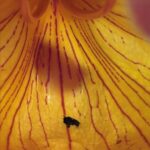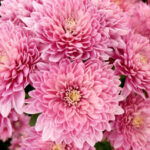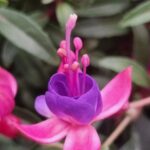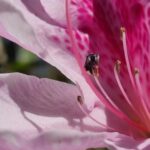Not all flowers are good for bees and other pollinators, in fact some of them are poisonous and will kill them!
For flowers to be beneficial to bees and other insect pollinators, they must produce pollen and or nectar.
There are many flowers that don’t have pollen or nectar. One example is Chrysanthemums. I love Chrysanthemums, they are beautiful flowers, however they do not produce pollen or nectar, and are pretty much useless for bees and other pollinators.
Many bedding Plants have been hybridised to create strains with uniform size, long-lasting flowers, bright colours, and a long retail ‘shelf life’. This has affected the production of pollen and nectar, and makes them inaccessible to pollinators.
Double flowered varieties have extra rows of petals, some of these prevent bees from collecting pollen or nectar, such as ‘Cactus’ and ‘Pompom’ Dahlias, ‘Mophead’ Chrysanthemums, and ‘Hybrid tea’ Roses.
Many plants, especially in the southern hemisphere, are not pollinated by insects at all, but by birds, or in some cases small mammals. Majority of them are inaccessible to bees and other pollinators. Some examples are; Fuchsia, Phormium, Callistemon, Crocosmia, Crinodendron, Embothrium, Kniphophia, Canna and Desfontainia.
Some plants have evolved to produce toxic nectar. Toxic nectar allows the flowers to repel the least effective pollinators and preserve pollen for more efficient pollinators not affected by the toxin.
One example is the African tulip trees. These were once a very popular tree used in Australian landscaping, until it was listed as a Class 3 pest and the sale and distribution became illegal. The natural pollinators of the African Tulip are bats or birds and the tree has evolved a mechanism to protect its pollen from being stolen from the early arriving bees, by killing them. There are plenty of other plants that are toxic to bees. Some of these include;
- Aesculus californica (Hippocastanaceae)
- Astragalus spp. (Fabaceae)
- Cuscuta spp. (Convolvulaceae)
- Cyrilla racemiflora (Cyrilliceae)
- Kalmia latifolia (Ericaceae)
- Solanum nigram (Solacanaceae)
- Veratrum californicum (Liliaceae)
- Zygadenus cenesosus (Liliaceae)
- Corynocarpus laevigata (Corynocarpaceae)
- Angelica triqueta (Apiciaceae)
- Astragalus lentiginosus (Fabaceae)
- Camellia thea (Theaceae)
- Ochrama lagopus (Bombacaceae)
- Sophora microphylla (Fabaceae)
- Tilia spp. (Tiliaceae)
- Verartrum californicum (Liliaceae)
- Asclepias spp. (Apocynaceae)
- Astragalus miser v. serotibus (Fabaceae)
- Rhododendrum spp. and hybrids (Ericaceae)
When planting flowers for bees, first and foremost make sure they aren’t poisonous. Secondly check that they actually produce pollen and nectar. Not all flowers are good for bees!
Thank you for reading! If you would like to purchase bee friendly seeds use the coupon code THANKS4READING for a discount.







Sources:
http://www.wlgf.org/plants_avoid.html
https://www.buzzaboutbees.net/Plants-Toxic-for-Bees.html
https://onlinelibrary.wiley.com/doi/abs/10.1034/j.1600-0706.2000.910301.x
https://www.bobthebeeman.com.au/information-documents/african-tulip-tree-ebook/
https://easy-beesy.com/are-azaleas-bad-for-bees-youll-be-surprised-at-the-answer/
Image Sources:
https://www.floraqueen.com/blog/the-chrysanthemum-meaning-is-deep-and-full-of-emotions-2
https://botanyphoto.botanicalgarden.ubc.ca/2017/07/veratrum-californicum/